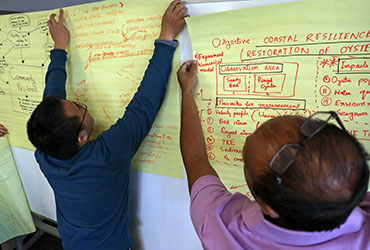Competition Process
Stage One



Open call for abstracts that outline the faculty-student teams as well as the particular research interests and expertise of the team. Based on the abstract/proposal, the Coastal Design Competition Committee will select no more than 6 teams to compete in Stage Two. See the CERF submission website for more information and requirements.
SUBMISSIONS DUE: OCTOBER 30, 2020
Stage One winners were announced November, 2020.
Stage Two - Design Competition
Selected abstracts/teams will use the spring and summer of 2021 to research and design a proposal in response to the design challenge. The teams will present at the 2021 CERF Conference. Entries will be juried and winners announced by a panel of experts during the Conference.
SUBMISSIONS DUE: MAY 2021



Student participation
The scope and extent of the project should be consistent with the level of a senior or graduate design or capstone course. Students are expected to work with the guidance of a lead professor or professors as well as seeking assistance from advisors, professors, and/or industry professionals and consultants. However, students must perform all work themselves. The students are expected to work together as a team to prepare a complete resilient design study and solution.
Students are expected to perform the necessary study, research, and literature review to complete the project. Students may use any printed or digital references or resources they choose, with appropriate citations. Lead professors should set the terms and physical scope of the project as well as guide the students in defining terms and limits of the project.
Design Challenge
The City of Hampton was founded in 1610 by English settlers on the lands of the indigenous community of Kecoughtan. The community was strategically located at the confluence of 3 rivers: the Elizabeth, the Nansemond, and the James forming the Hampton Roads, which is part of the larger Tidewater area of Virginia and connected to the Chesapeake Bay. Hampton, and the site 2021 CERF SDC teams will be focused on, is also the location of Point Comfort (near Fort Monroe), where the first African slaves arrived in North America in 1619.
Contemporary Hampton is the home of many significant institutions including Hampton University, Langley Air Force Base, NASA Langley Research Center, and the Virginia Air and Space Center.
Over the last two decades, Hampton has experienced a high rate of climate change-related shocks and stresses. In the coming years, the rate and intensity of the shocks and stresses is expected to escalate. Teams in the CERF 2021 Student Design Competition should provide the research and novel solutions to their problems, which include:
- Recurring flooding with associated property damage and business continuity interruptions due to loss of wetlands and protective natural systems.
- Loss of fishing economy due to contaminated waterways and systems as well as habitat migration.
Teams should use a resilience assessment rubric to study and understand the local conditions including risk tolerances, vulnerabilities, and strengths.
Scale of projects
Research and analysis should be at multiple scales. Initial research should be at the quadrant scale indicated on the provided maps but could expand to include the entire watershed and could focus as tightly as the single lot or parcel. Final design proposal scale will be determined by the teams and the expertise of the teams.
Design Timeframe
Planning and design for a minimum of 30 years of resilience using the NOAA Intermittent Curve (Comprehensive planning).
Components of the project
A typical resilient design project includes many or all of the following components:
- Sufficient background information with a clearly stated problem statement;
- Analysis of any alternative solutions which may include a decision matrix
- Ecosystem profile;
- Community profile;
- Analysis of strengths, risks, and vulnerabilities of the study area;
- Proposal of solution(s) that mitigate or adapt to risks and vulnerabilities
- Preliminary implementation plan.
All of the design work should be submitted in the design report, clearly labeled and referenced.
Entry Requirements
Teams will compete through a written and visual submission and an oral presentation. See below for information on submission deadlines for each of these deliverables.
- Design Report;
- Oral/visual presentation for the special session format; and
- Posters for an exhibition display at the 2021 CERF Conference
- Design Report containing all research and design proposals and complying with the requirements set forth in this document must accompany each entry.
- Presentation with oral and visual components that summarizes the project for the judging panel during the special session. Each team’s presentation will be 20 minutes followed by up to a 10-minute question and answer period. Team presentations will be held to the 20-minute time limitation and will not be permitted to continue beyond the limit. The presentation files shall be saved in a format provided by the CERF SDC Committee and submitted per the requirements provided. The file submitted will be the version presented at the competition. Teams will not be permitted to revise the files.
- Posters for display in virtual gallery format during the conference and formatted for printing.
Design Report Requirements — Due on October 18, 2021, 5PM EST — updated 8/21/21
The design report shall be a single volume comprised of the documents that describe the problem, evaluation, recommendations, and design solution. The project name, university name (team name), year, and entrants’ names shall be included on the front cover of the design report. Page size should be 8 ½”x11”.
An electronic copy of the design report shall be created in a single PDF format file that is organized with cover pages, table of contents, report sections, and appendices, if used. The single PDF file shall be uploaded to a collection site as directed by the SDC Committee. Failure to submit the electronic copy in a PDF format will result in a deduction to the team’s overall score.
The report must be submitted to the SDC Committee by the stated deadline. Non-compliance with these requirements will result in penalties (see below). Project materials may not be returned to team after the competition. Teams should produce a copy of their materials for their own records.
The design report shall include, in the following order:
Cover Page – with project name, university name (team name), year, and entrants’ names.
Table of ContentsAbstract – a brief summary of the design, not to exceed 200 words.
Summary of Project Team Effort – Provide a 1 to 2-page summary of the project team effort, including:
- Each team member’s name and role in the effort (including faculty)
- Names of any other individuals that assisted in the effort
- Consultants who facilitated the design project
Project Description – Provide a description of the design problem, site evaluation, and recommended design solution (not to exceed 20 pages*), including the following information:
- Statement of design problem.
- Discussion of alternatives evaluation – Discussion should provide a clear description of the alternatives and evaluation technique.
- Description of recommended design solution – Discussion must cover the salient facts upon which the recommendation is made, present a clear recommendation of action, and provide bases for design. Relevant data should be presented in a clear manner. All elements shown on the judging form should be addressed, including economic analysis.
- Formatting to include a minimum of 0.75-inch margins on all sides; Calibri, Arial, Times New Roman or similar font with a minimum 11-point font size.
- Pages of the Project Description portion of the report shall be continuously numbered.
- Plans, visualizations, diagrams, graphics, plots, and photographs may be included that reflect the unique features of the project. Each is to be identified with an appropriate descriptive caption. Graphics/photos included within the project description will count toward the 20 page limit.
- Text should be a maximum of 3500 words, excluding titles and captions.
*The number of pages used in the Project Description is checked to ensure compliance with the 20 page limit.
Supporting Documentation – If needed, provide additional drawings, calculations, tables, and other voluminous documents, as appendices.
References/Acknowledgements – All references and resources used for this project shall be cited appropriately.
The judges will be directed to focus their review on the Project Description section of the design reports. Teams shall develop their materials such that their complete analysis and design solution may be understood from the 20 pages of material provided in the Project Description.
Teams are encouraged to use a checklist to ensure all necessary documents are included in the design reports. Failure to ensure all documents are accounted for may result in a team penalty. The SDC Committee will not review any submittal prior to the official submission.
Presentation Requirements — Due on October 18, 2021, 5PM EST
A visual digital slide presentation describing the team’s design problem, approach, evaluation, design effort, and recommendations is required. This information will be presented by the team during the oral portion of the competition at the CERF Conference. Prior to the competition, the single file must be uploaded to a collection site as directed by the SDC Committee. Teams should work to assure compliance for images, graphics and any video across multiple platforms prior to submitting. The presentation file must be submitted to the SDC Committee by the stated deadline. Non-compliance with these requirements may result in penalties (see below). Project materials may not be returned to teams after the competition. Teams should produce a copy of their materials for their own records.
Both written and oral presentations are subject to questioning during the question and answer period. However, questioning is limited to the judging panel only.
Competition Poster Requirements — Due on October 18, 2021, 5PM EST
- Posters for an exhibition display at the 2021 CERF Conference.
- Size requirement – Widescreen (16:9)
Evaluation Criteria
Proposals will be evaluated in the following categories:
- Research and analysis of natural and human systems impacting the site area.
- Innovative design proposals
- Clarity of presentation and convincing argumentation in the presentation
It is recognized that all professionals must possess a well-developed ability to communicate visually, orally and in writing. The competition is designed to emphasize the value of delivering both high-quality written and visual reports and oral presentations. Scoring of the design will be determined through an evaluation of both the competitors’ written and oral presentation skills, along with the content of the design solution. Scoring sheets have been developed for evaluating both the written (design report) and the oral presentations and will be used by the judges as the basis for judging all competing teams.
The written submission (in electronic format) will be evaluated by the judges and scores for the written submission of the competition will be submitted to the Subcommittee prior to the oral presentations. An electronic copy of the written report will be available to the judges during the oral presentation for their reference.
During the competition held at the CERF Conference, the oral presentations will be evaluated by the judges, based on both the quality of the presentation and proficiency in answering questions in the ensuing judge Q&A period. Scores for the oral presentations will be submitted by the judges to the SDC Committee.
A representative of the SDC Committee will compile the written and oral presentation scores and determine the final ranking of the teams participating in the competition. All scores will be kept confidential. Judges’ comments regarding that team’s performance will be provided following the completion of the CERF Student Design Competition. It is intended that final presentation boards will be publicly available online following the competition.
The order of team presentations will be selected at random prior to the competition. Teams will be notified of their time slot prior to the CERF Student Design Competition. Student teams are encouraged to be present for the entire day of the oral presentations through the conclusion of awards announcements.
Judging Criteria
The CERF Student Design Competition is intended to be multi-disciplinary. Accordingly, judging will be based on the elements outlined below and in the scoring sheets provided in Attachment C. The SDC Committee reserves the right to adjust the format and content of the scoring sheets provided in Attachment C. Participating teams will be provided with a copy of the revised sheets prior to the competition if such adjustments are made.
DESIGN REPORT:
- Scientific/Design. Was the Project Description section of the report organized effectively with a Statement of Problem, appropriate background information, clear description of the resilience factors, etc? Was a continuous, logical sequence of steps taken to solve the design problem? Was the recommended solution feasible and appropriate to address the problem statement? Was creativity and an innovative approach used? Was knowledge of subject matter demonstrated? How was the community considered and engaged in the solution? Was the design solution analyzed for feasibility; was this analysis presented? Were works cited and credit to resources and assistance correctly presented? Was the complete analysis and design solution presented clearly within the 20-page Project Description?
- Presentation. Were visual aids (plans, graphics, supporting info, pictures, etc.), presented clearly? Were correct grammar, correct spelling, and appropriate technical writing methods used? Was the formatting and organization of the report presented in a logical manner?
ORAL PRESENTATION:
- Content. Was scientific subject matter relevant to design? To what extent was subject of interest to a general audience? Was knowledge of subject and presentation content exhibited by team members? Was the work presented independent and original? Was credit given for source of material or contribution by others? Was there any novel approach to the solution?
- Organization. Was there sufficient background information provided in order to introduce the audience to the subject? Were facts developed in logical and continuous sequence? Was there a definite conclusion and was it adequately based on the facts or data presented?
- Delivery and Effectiveness. Was appropriate volume used to reach all audience members? Was the vocabulary used sufficient? Were the words distinctly pronounced? Was personal appearance appropriate? Was the manner of delivery (conversation, memorized, read from manuscript) satisfactory? Were visual aids effectively used?
- Discussion. Did the presentation evoke spontaneous questions from the panel? Did questions indicate the need for clarification of facts presented or were they merely of the type seeking additional information? Did the answers indicate knowledge of the subject beyond that disclosed in the original presentation?
The judges will have the opportunity to comment on the design reports and presentations during the judging process. Judging comments for each submission will be made available to the corresponding team after the competition at the request of the team. Teams will not be allowed to view any scores from the competition, including their own.
Competition Rules (UPDATED)
- All teams should agree to work with specified local contacts for information rather than contacting community groups directly.
- Teams must be composed of students led by faculty mentors.
- Teams must consist of at least three disciplines and must have one design discipline (architecture, landscape architecture, urban design, etc) as well as one coastal and estuarine science (ecology, environmental science, hydrology, geomorphology, etc) discipline represented on the team.
- Connections with underrepresented groups are encouraged along with diverse teams and thoughtful inclusion of regional Minority Serving Institutions.
- Teams are responsible for the development of their own graphics and presentation methods but must follow the guidelines provided by the CERF hosts.
- Teams may include more than one academic institution
Teams are six students max- Faculty-student teams may partner with A&E firms and other professional consultants, but research and design must be performed by the students.
Penalties:
Failure to comply with the above requirements may result in penalties to a team’s final score. Teams will be notified of the penalties they have received prior to the competition at CERF. Penalties are at the discretion of the SDC Committee and may include, but are not limited to, the following:
- Failure to submit an electronic copy of the design report in PDF format within the guidelines set forth herein;
- Failure to submit the slide presentation within the guidelines set forth herein; and
- Failure to submit entries on-time.
Competition Timeline (UPDATED)
- Fall 2020 – Stage One Abstracts submitted / Stage Two teams selected
- Dec 2020 – Team Q&A
- Spring and Summer 2021 – Teams complete Stage Two projects
- May 5 – Abstract submission for CERF 2021 Conference Program DUE
- October 18 – Design Report, Presentation slides AND Poster DUE
- November 8 – FINAL DESIGN PRESENTATION AND JUDGING BEGINS AT 2:30-6:30PM; AWARDS RECEPTION AT 7:00PM~ ALL ONLINE
- Fall 2021 – 2021 CERF Conference VIRTUAL
